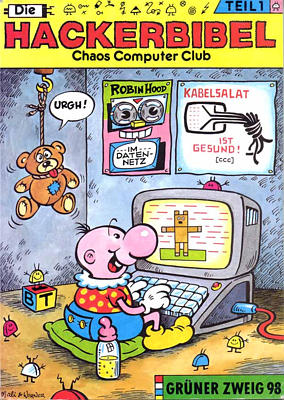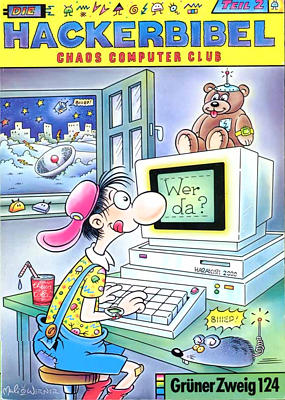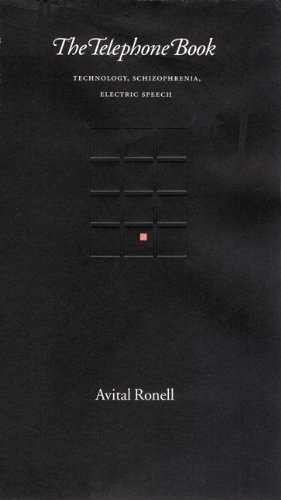Chaos Computer Club (ed.): Die Hackerbibel, 1-2 (1985, 1988) [German]
Filed under book | Tags: · computing, germany, hacker culture, hacking, history of computing, history of technology, internet, machine, networks, privacy, programming, radio, security, technology, telephone, video


“Die Hackerbibel ist eine Publikation des Chaos Computer Clubs. Sie ist bisher in zwei Ausgaben in den Jahren 1985 und 1988 erschienen. Beide Ausgaben wurden von Wau Holland herausgegeben und vom Verlag Grüne Kraft veröffentlicht.
Die Hackerbibel ist ein Sammelsurium aus Dokumenten und Geschichten der Hacker-Szene, wie beispielsweise die Bauanleitung für den als „Datenklo“ betitelten Akustikkoppler. Sie bietet darüber hinaus Bauanleitungen und andere technische Hintergründe. Die 1. Ausgabe erschien 1985 mit dem Untertitel Kabelsalat ist gesund, und erzielte bis Mitte 1988 eine verkaufte Auflage von 25.000 Exemplaren. Die Ausgabe 2 aus dem Jahr 1988 wird auch Das neue Testament genannt. Die Comic-Zeichnungen der Umschlagbilder sind eine Schöpfung der deutschen Comic-Zeichner Mali Beinhorn und Werner Büsch von der Comicwerkstatt Büsch-Beinhorn. Die Produktion und der Vertrieb der Hackerbibel wurde schon vor 1990 eingestellt. Seit 1999 bietet der CCC eine gescannte und im Volltext verfügbare Version mit weiterem Material, wie Texte von Peter Glaser, eine Dokumentation zu Karl Koch und die Arbeiten von Tron, auf der Chaos-CD an.” (wikipedia)
Die Hackerbibel Teil 1. Kabelsalat ist gesund, Grünen Kraft, Löhrbach, ISBN 3922708986, 260 Seiten
Die Hackerbibel Teil 2. Das neue Testament, Grünen Kraft, Löhrbach, ISBN 3925817247, 260 Seiten
PDF (Teil 1, 56 MB, no OCR, updated on 2024-2-3)
HTML (Teil 1, updated on 2024-2-3)
PDF (Teil 2, 43 MB, no OCR, updated on 2024-2-3)
HTML (Teil 2, updated on 2024-2-3)
Lisa Gitelman, Geoffrey B. Pingree (eds.): New Media, 1740-1915 (2003)
Filed under book | Tags: · history of technology, media, media archeology, media history, new media, phonograph, stereoscope, telephone

Reminding us that all media were once new, this book challenges the notion that to study new media is to study exclusively today’s new media. Examining a variety of media in their historic contexts, it explores those moments of transition when new media were not yet fully defined and their significance was still in flux. Examples range from familiar devices such as the telephone and phonograph to unfamiliar curiosities such as the physiognotrace and the zograscope. Moving beyond the story of technological innovation, the book considers emergent media as sites of ongoing cultural exchange. It considers how habits and structures of communication can frame a collective sense of public and private and how they inform our apprehensions of the “real.” By recovering different (and past) senses of media in transition, New Media, 1740-1915 promises to deepen our historical understanding of all media and thus to sharpen our critical awareness of how they acquire their meaning and power.
Contributors:
Wendy Bellion, Erin C. Blake, Patricia Crain, Ellen Gruber Garvey, Lisa Gitelman, Geoffrey B. Pingree, Gregory Radick, Laura Burd Schiavo, Katherine Stubbs, Diane Zimmerman Umble, Paul Young.
Publisher MIT Press, 2003
Media in Transition series
ISBN 0262072459, 9780262072458
271 pages
Download (removed on 2013-11-12 upon request of the publisher)
Comment (0)Avital Ronell: The Telephone Book: Technology, Schizophrenia, Electric Speech (1989)
Filed under book | Tags: · history of technology, psychoanalysis, schizophrenia, speech, technology, telephone

“The telephone marks the place of an absence. Affiliated with discontinuity, alarm, and silence, it raises fundamental questions about the constitution of self and other, the stability of location, systems of transfer, and the destination of speech. Profoundly changing our concept of long-distance, it is constantly transmitting effects of real and evocative power. To the extent that it always relates us to the absent other, the telephone, and the massive switchboard attending it, plugs into a hermeneutics of mourning. The Telephone Book, itself organized by a “telephonic logic,” fields calls from philosophy, history, literature, and psychoanalysis. It installs a switchboard that hooks up diverse types of knowledge while rerouting and jamming the codes of the disciplines in daring ways. Avital Ronell has done nothing less than consider the impact of the telephone on modern thought. Her highly original, multifaceted inquiry into the nature of communication in a technological age will excite everyone who listens in.
The book begins by calling close attention to the importance of the telephone in Nazi organization and propaganda, with special regard to the philosophy of Martin Heidegger. In the Third Reich the telephone became a weapon, a means of state surveillance, “an open accomplice to lies.” Heidegger, in Being and Time and elsewhere, elaborates on the significance of “the call.” In a tour de force response, Ronell mobilizes the history and terminology of the telephone to explicate his difficult philosophy.
Ronell also speaks of the appearance of the telephone in the literary works of Duras, Joyce, Kafka, Rilke, and Strindberg. She examines its role in psychoanalysis—Freud said that the unconscious is structured like a telephone, and Jung and R. D. Laing saw it as a powerful new body part. She traces its historical development from Bell’s famous first call: “Watson, come here!” Thomas A. Watson, his assistant, who used to communicate with spirits, was eager to get the telephone to talk, and thus to link technology with phantoms and phantasms. In many ways a meditation on the technologically constituted state, The Telephone Book opens a new field, becoming the first political deconstruction of technology, state terrorism, and schizophrenia. And it offers a fresh reading of the American and European addiction to technology in which the telephone emerges as the crucial figure of this age.”
Publisher University of Nebraska Press, 1989
ISBN 0803289383, 9780803289383
466 pages
PDF (8 MB, added on 2015-7-21)
DJVU (9 MB, updated on 2012-8-5)

